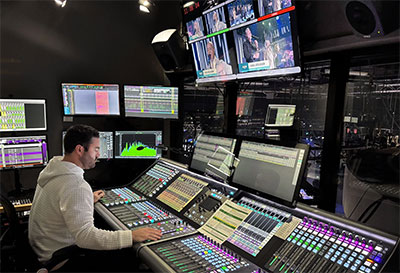The American evangelical Christian-based religious television broadcaster Daystar Television Network has upgraded the audio capabilities at its production studio complex in the Dallas-Fort Worth Metroplex with the installation of a custom configured, dual-operator Solid State Logic System T S500 broadcast audio platform and a pair of SSL Live L550 Plus mixing consoles.
The network, which reaches more than 2bn homes worldwide, has additionally installed two System T Furniture Fader Tiles, one with a Tempest Control Rack, together with an SSL Live Remote Expander plus a pair of Live Remote Tiles.
 Installed in Daystar’s Broadcast Audio Control (BAC), the System T platform features a dual S500 frame outfitted with two master sections and three touchscreens with five Fader Tiles providing access to 80 channel faders. Powered by redundant TE2 Tempest Engines licenced for 800 paths at 48kHz, the control surface provides two operators with independent control over their respective mixes and duties.
Installed in Daystar’s Broadcast Audio Control (BAC), the System T platform features a dual S500 frame outfitted with two master sections and three touchscreens with five Fader Tiles providing access to 80 channel faders. Powered by redundant TE2 Tempest Engines licenced for 800 paths at 48kHz, the control surface provides two operators with independent control over their respective mixes and duties.
The principal mixer handles all dialogue and vocal microphones as well as video roll-ins and external remote sources, including a direct feed from Daystar’s studio in Jerusalem, Israel. In addition to managing the band instrument sources, the secondary mixer handles mix-minus feeds, playback sources and 192 channels of DAW recording and playback. The room handles both broadcast and post-production mixing or remixing. For broadcasts, the BAC System T generates a 5.1 mix along with stereo and mono downmixes, mix-minus dialogue, dialogue-only and instrument-only feeds.
The network’s flagship broadcast, Ministry Now, produced live daily, is hosted by Daystar co-founder and president Joni Lamb – who also presents daily discussion show Joni Table Talk – alongside her husband, Dr Doug Weiss.
‘The main live show that we do here has a band and singers,’ says Director of Audio, David Ribb. ‘There’s so much traffic going on and, because of the pacing, we have found it easier to have two people mixing. Plus, twice a year, we do a special version of that show. That was the main reason we made the System T surface as large as we did, in addition to our input count.’
An Live L550 Plus in Studio Audio Control (SAC) sends more than 60 feeds to various line arrays and nearly two dozen loudspeaker zones in the main studio, which houses multiple set locations in addition to a band performance area, as well as wedge monitors and wired and wireless IEM and IFB feeds. A second Live 550 Plus on the studio floor manages monitor mixes for the singers and the band, feeding IEMs and a 128-channel Klang immersive mixing system with a combination of direct sources and mix stems.
According to Audio Systems Engineer Doug Leake, the three new consoles have noticeably improved production audio quality, especially on the stage: ‘It’s a quite lively environment for a television studio, because there’s a group of people that like to hear the same kind of energy and momentum that you would find in a modern, contemporary church service or performance venue,’ he says. ‘Everyone has noticed a big sonic difference. Many of the singers that are on in-ears, or just hearing how it sounds in the main PA out in the room, have commented on how well it’s translating and sounding.’
In terms of live microphones, there can be as many as 14 lavaliere mics and up to 12 handheld wireless mics for speech applications on Daystar’s flagship show. In addition, there are typically 12 to 14 singers with a large house band and potentially up to ten guest vocalists, while a further 32 channels are reserved for guest band instruments. To handle the high channel count, Daystar is making extensive use of SSL’s Automix, which is found on both System T and Live consoles.
‘Most, if not all, of the productions that we produce in-house are interview-based or have multiple talking microphones,’ Ribb says. ‘It can get up to 10 to 12 mics very easily, so that Automix functionality is tremendously useful on the broadcast side. But it even comes in handy on the studio side, helping clean up the mix environment.’
All three consoles have access to a variety of SSL Net I/O interfaces and converters over the Dante network, including nine SB32.24 Dante Stageboxes interfaced via a pair of X-Light Bridges. A Blacklight-II Bridge and a pair of Madi-Bridges further facilitate I/O across the network. Additionally, there are three SB 16.12 stageboxes and a single SB 8.8 stagebox, plus an A16.D16 interface.
‘SSL’s online support was very helpful to us trying to troubleshoot some of the challenges and has been a great bonus, Ribb notes in conclusion. ‘The SSL support team has been very, very helpful, not just in commissioning, but also continuous follow-up and working through things.’
More: www.solidstatelogic.com













